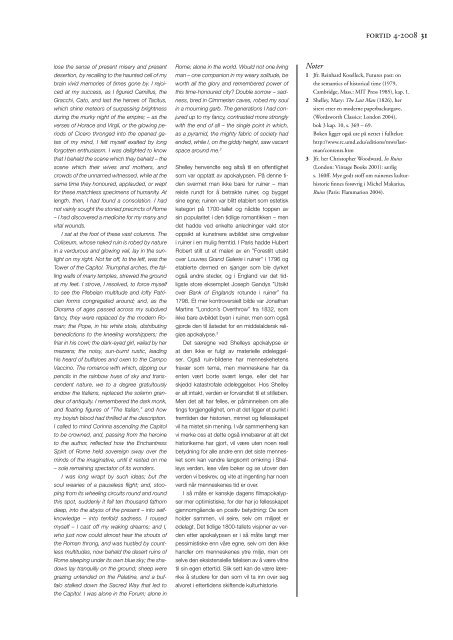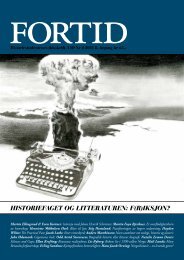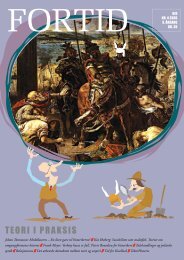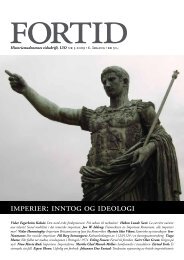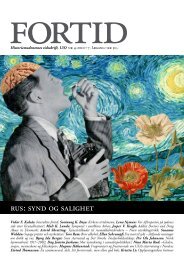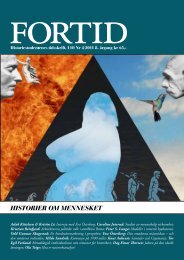You also want an ePaper? Increase the reach of your titles
YUMPU automatically turns print PDFs into web optimized ePapers that Google loves.
lose the sense of present misery and present<br />
desertion, by recalling to the haunted cell of my<br />
brain vivid memories of times gone by. I rejoiced<br />
at my success, as I figured Camillus, the<br />
Gracchi, Cato, and last the heroes of Tacitus,<br />
which shine meteors of surpassing brightness<br />
during the murky night of the empire; – as the<br />
verses of Horace and Virgil, or the glowing periods<br />
of Cicero thronged into the opened gates<br />
of my mind, I felt myself exalted by long<br />
forgotten enthusiasm. I was delighted to know<br />
that I beheld the scene which they beheld – the<br />
scene which their wives and mothers, and<br />
crowds of the unnamed witnessed, while at the<br />
same time they honoured, applauded, or wept<br />
for these matchless specimens of humanity. At<br />
length, then, I had found a consolation. I had<br />
not vainly sought the storied precincts of Rome<br />
– I had discovered a medicine for my many and<br />
vital wounds.<br />
I sat at the foot of these vast columns. The<br />
Coliseum, whose naked ruin is robed by nature<br />
in a verdurous and glowing veil, lay in the sunlight<br />
on my right. Not far off, to the left, was the<br />
Tower of the Capitol. Triumphal arches, the falling<br />
walls of many temples, strewed the ground<br />
at my feet. I strove, I resolved, to force myself<br />
to see the Plebeian multitude and lofty Patrician<br />
forms congregated around; and, as the<br />
Diorama of ages passed across my subdued<br />
fancy, they were replaced by the modern Roman;<br />
the Pope, in his white stole, distributing<br />
benedictions to the kneeling worshippers; the<br />
friar in his cowl; the dark-eyed girl, veiled by her<br />
mezzera; the noisy, sun-burnt rustic, leading<br />
his heard of buffaloes and oxen to the Campo<br />
Vaccino. The romance with which, dipping our<br />
pencils in the rainbow hues of sky and transcendent<br />
nature, we to a degree gratuitously<br />
endow the Italians, replaced the solemn grandeur<br />
of antiquity. I remembered the dark monk,<br />
and floating figures of ”The Italian,” and how<br />
my boyish blood had thrilled at the description.<br />
I called to mind Corinna ascending the Capitol<br />
to be crowned, and, passing from the heroine<br />
to the author, reflected how the Enchantress<br />
Spirit of Rome held sovereign sway over the<br />
minds of the imaginative, until it rested on me<br />
– sole remaining spectator of its wonders.<br />
I was long wrapt by such ideas; but the<br />
soul wearies of a pauseless flight; and, stooping<br />
from its wheeling circuits round and round<br />
this spot, suddenly it fell ten thousand fathom<br />
deep, into the abyss of the present – into selfknowledge<br />
– into tenfold sadness. I roused<br />
myself – I cast off my waking dreams; and I,<br />
who just now could almost hear the shouts of<br />
the Roman throng, and was hustled by countless<br />
multitudes, now beheld the desert ruins of<br />
Rome sleeping under its own blue sky; the shadows<br />
lay tranquilly on the ground; sheep were<br />
grazing untended on the Palatine, and a buffalo<br />
stalked down the Sacred Way that led to<br />
the Capitol. I was alone in the Forum; alone in<br />
Rome; alone in the world. Would not one living<br />
man – one companion in my weary solitude, be<br />
worth all the glory and remembered power of<br />
this time-honoured city? Double sorrow – sadness,<br />
bred in Cimmerian caves, robed my soul<br />
in a mourning garb. The generations I had conjured<br />
up to my fancy, contrasted more strongly<br />
with the end of all – the single point in which,<br />
as a pyramid, the mighty fabric of society had<br />
ended, while I, on the giddy height, saw vacant<br />
space around me. 2<br />
Shelley henvendte seg altså til en offentlighet<br />
som var opptatt av apokalypsen. På denne tiden<br />
svermet man ikke bare for ruiner – man<br />
reiste rundt for å betrakte ruiner, og bygget<br />
sine egne; ruinen var blitt etablert som estetisk<br />
kategori på 1700-tallet og nådde toppen av<br />
sin popularitet i den tidlige romantikken – men<br />
det hadde ved enkelte anledninger vakt stor<br />
oppsikt at kunstnere avbildet sine omgivelser<br />
i ruiner i en mulig fremtid. I Paris hadde Hubert<br />
Robert stilt ut et maleri av en ”Forestilt utsikt<br />
over Louvres Grand Galerie i ruiner” i 1796 og<br />
etablerte dermed en sjanger som ble dyrket<br />
også andre steder, og i England var det tidligste<br />
store eksemplet Joseph Gandys ”Utsikt<br />
over Bank of Englands rotunde i ruiner” fra<br />
1798. Et mer kontroversielt bilde var Jonathan<br />
Martins ”London’s Overthrow” fra 1832, som<br />
ikke bare avbildet byen i ruiner, men som også<br />
gjorde den til åstedet for en middelaldersk religiøs<br />
apokalypse. 3<br />
Det særegne ved Shelleys apokalypse er<br />
at den ikke er fulgt av materielle ødeleggelser.<br />
Også ruin-bildene har menneskehetens<br />
fravær som tema, men menneskene har da<br />
enten vært borte svært lenge, eller det har<br />
skjedd katastrofale ødeleggelser. Hos Shelley<br />
er alt intakt, verden er forvandlet til et stilleben.<br />
Men det alt har felles, er påminnelsen om alle<br />
tings forgjengelighet, om at det ligger et punkt i<br />
fremtiden der historien, minnet og fellesskapet<br />
vil ha mistet sin mening. I vår sammenheng kan<br />
vi merke oss at dette også innebærer at alt det<br />
historikerne har gjort, vil være uten noen reell<br />
betydning for alle andre enn det siste mennesket<br />
som kan vandre langsomt omkring i Shelleys<br />
verden, lese våre bøker og se utover den<br />
verden vi beskrev, og vite at ingenting har noen<br />
verdi når menneskenes tid er over.<br />
I så måte er kanskje dagens filmapokalypser<br />
mer optimistiske, for der har jo fellesskapet<br />
gjennomgående en positiv betydning: De som<br />
holder sammen, vil seire, selv om miljøet er<br />
ødelagt. Det tidlige 1800-tallets visjoner av verden<br />
etter apokalypsen er i så måte langt mer<br />
pessimistiske enn våre egne, selv om den ikke<br />
handler om menneskenes ytre miljø, men om<br />
selve den eksistensielle følelsen av å være vitne<br />
til sin egen ettertid. Slik sett kan de være lærerike<br />
å studere for den som vil ta inn over seg<br />
alvoret i ettertidens skiftende kulturhistorie.<br />
fortid 4-<strong>2008</strong> 1<br />
Noter<br />
1 Jfr. Reinhard Koselleck, Futures past: on<br />
the semantics of historical time (1979,<br />
Cambridge, Mass.: MIT Press 1985), kap. 1.<br />
2 Shelley, Mary: The Last Man (1826), her<br />
sitert etter en moderne paperbackutgave,<br />
(Wordsworth Classics: London 2004),<br />
bok 3 kap. 10, s. 369 – 69.<br />
Boken ligger også ute på nettet i fulltekst:<br />
http://www.rc.umd.edu/editions/mws/lastman/contents.htm<br />
3 Jfr. her Christopher Woodward, In Ruins<br />
(London: Vintage Books 2001): særlig<br />
s. 160ff. Mye godt stoff om ruinenes kulturhistorie<br />
finnes forøvrig i Michel Makarius,<br />
Ruins (Paris: Flammarion 2004).


